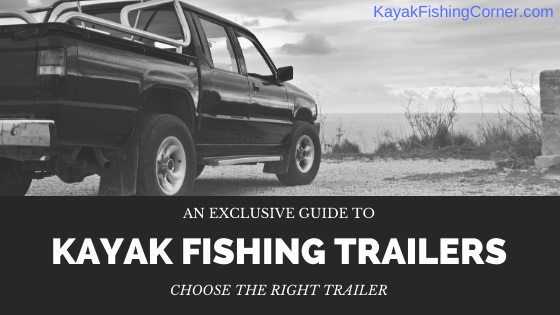Jump Ahead To:
KAYAK TRAILER INTRO
Is the term “kayak trailer” one that is not yet familiar to you? It won’t be for long! Let’s face it, kayak fishing is only possible if you can actually transport your fishing kayak to the waterway, unless, of course, you are one of those lucky enough to have your own dock. Fishing kayaks are large, relatively heavy, and fairly cumbersome to transport.
The need for a methodology by which to transport a fishing kayak was readily apparent for many years, and only recently has there been an answer to the dilemma: How to best transport your fishing kayak? The answer comes in the form of a “kayak trailer”. A kayak trailer can come in many styles, largely depending on the avenue by which you intend to move your fishing kayak (vehicle, trailer or land).
KAYAK TRAILER ULTIMATE GUIDE
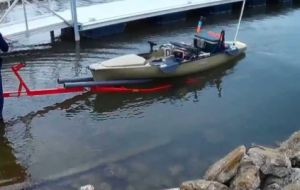
First, as an Amazon Associate, I earn from qualifying purchases.
KayakFishingCorner.com has spent hours learning about the kayak trailer. In this Kayak Trailer Ultimate Guide, we have listed all of the important details and features of a high quality trailer.
We have separated these important details and features into basic categories including vehicle based, trailer based, and land based. We have also included a link to one of our favorite types of kayak trailer toward the bottom of this guide!
Kayak Trailer Basics
Please note: This post contains affiliate links. An affiliate link means that we may earn advertising/referral fees if you make a purchase through our links.
Shortcut to Kayak Trailer Review #1
Shortcut to Kayak Trailer Review #2
Shortcut to Kayak Trailer Review #3
Shortcut to Kayak Trailer Review #4
The term kayak trailer is used to describe so many different kinds of kayak fishing products. Above, we depict a “trailer” in the traditional sense, as it is designed to actually be used to trailer a load behind a vehicle, usually a truck or SUV.
While these kind of trailers most appropriately fit the definition of a “trailer”, you will also see many other products referred to as trailers. Sometimes these other products are more commonly and accurately referred to as kayak racks, kayak carts, or hitch extenders.
Regardless of the name, the purpose of each of these products is the same – to assist a kayak fisherman in moving his or her fishing kayak from one particular location to a second location. Of course, depending on the desired destination, a kayak fisherman might use several of the various kayak trailers on any given fishing trip.
First, she might use a traditional trailer to haul the fishing kayak down the highway, or she might find that a kayak rack is more suitable given the bumpy terrain.
Then, she might offload the kayak from the trailer or kayak rack, and navigate the last few or even several hundred feet to the water via kayak cart or kayak trolley.
These smaller sized kayak trailers are perfect for taking you and your fishing kayak where vehicles can’t easily navigate. Let’s take a look at several of these types of kayak trailers below and learn how you might use them for kayak fishing!
How to Use a Kayak Trailer
Each of the distinct types of kayak trailer are going to have a different method of proper usage technique, but they all follow roughly the same process. Let’s take a look at some of the basics of how to use the different types of kayak trailer.
How to use a Kayak Rack

- Attach the kayak rack to your vehicle’s roof rack.
- Visually inspect the connection points to ensure a sound attachment.
- Safely raise your fishing kayak and rest it upon the kayak rack.
- Adjust the position of the fishing kayak to ensure an appropriate distribution of weight.
- Loop the straps around the fishing kayak, ensuring that they aren’t tangled or twisted.
- Tighten the kayak straps by tension, ratchets or elasticity.
- Confirm that the fishing kayak is safely attached to the kayak rack by pulling the kayak forward, pushing it backward, and rocking it from side to side.
- It is normal for the fishing kayak to move slightly, but only just an inch or so, before it returns to its original resting point. If the kayak moves any further than an inch, check your weight distribution or the tension of the kayak straps.
- After the kayak is secured to the kayak rack, and the kayak rack is secured to the vehicle, you can set off for your destination!
How to use a Kayak Cart
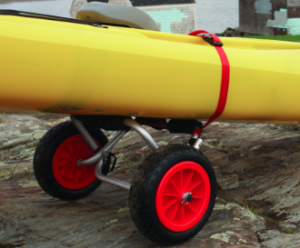
- Assemble the kayak cart into its transportation mode per the kayak cart instructions.
- Visually inspect the moving pieces to ensure the connections are tight, the joints sound, and the pieces are in good working order.
- Safely lower your fishing kayak and rest it upon the kayak cart.
- Adjust the position of the fishing kayak to ensure an appropriate distribution of weight. This is usually accomplished by placing the hull over the center of the kayak cart.
- Loop the straps around the fishing kayak, ensuring that they aren’t tangled or twisted.
- Tighten the kayak straps by tension, ratchets or elasticity.
- Confirm that the fishing kayak is safely attached to the kayak cart by pulling and pushing from front and back, and by rocking the kayak cart from side to side.
- It is normal for the fishing kayak to move slightly, but only just an inch or so, before it returns to its original resting point. If the kayak moves any further than an inch, check your weight distribution or the tension of the kayak straps.
- After the kayak is secured to the kayak cart, and all of the components are in good working order, you are all set to use the kayak cart to navigate to the water!
How to use a Kayak Trailer
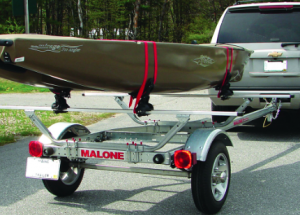
- Assemble the kayak trailer per the trailer instructions. Part of this assembly will require installation of navigation and braking lights per your local state law, typically requiring brake lights and turn signals.
- Confirm that your navigation and brake lights are in good working order after you’ve connected the wiring to your vehicle’s trailer connection port.
- Visually inspect the moving pieces of the kayak trailer to ensure the connections are tight, the joints sound, and the pieces are in good working order.
- Check your tire pressure by using a tire pressure air gauge. Ensure that the kayak trailer tires do not exceed the manufacturer’s suggested levels, and be certain to not under inflate as well.
- Safely lower your fishing kayak and rest it upon the kayak trailer.
- Again check your tire pressure to ensure that levels have not deviated outside of safe limits after subjecting the trailer to the weight of the fishing kayak.
- Adjust the position of the fishing kayak to ensure an appropriate distribution of weight.
- Loop the straps around the fishing kayak, ensuring that they aren’t tangled or twisted.
- Tighten the kayak straps by tension, ratchets or elasticity.
- Confirm that the fishing kayak is safely attached to the trailer by pulling and pushing it from front and back, and by rocking the kayak trailer and fishing kayak from side to side.
- It is normal for the fishing kayak to move slightly, but only just an inch or so, before it returns to its original resting point. If the kayak moves any further than an inch, check your weight distribution or the tension of the kayak straps.
- After the kayak is secured to the kayak trailer, the kayak trailer secured to your vehicle’s tow hitch, and all of the parts of the kayak trailer are in good working order, you are all set to trailer to the designation of your choice!
Kayak Trailer – Kayak Rack Basics
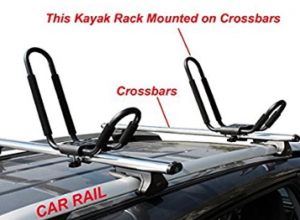
The first type of style is the vehicle based kayak trailer. This style typically comes in the form of a mount secured to the top of an SUV style roof rack cross bar. This type of kayak trailer features a “J Mouth” design, wide enough to allow you to insert your fishing kayak with ease, yet supportive in a manner that keeps the fishing kayak safe while in transportation over bumpy roads and at high speeds.
This type of kayak trailer is often built of steel, and features additional padding via rubberized joints at all points of contact, which aids in keeping your fishing kayak safe from bumps and bruises.
Conveniently, this vehicle based product features hardware to allow you to quickly and easily connect the trailer to your SUV’s crossbar when you want to travel with your fishing kayak, and then disconnect the product when you desire to use your vehicle for unrelated purposes without leaving the kayak trailer attached to the roof.
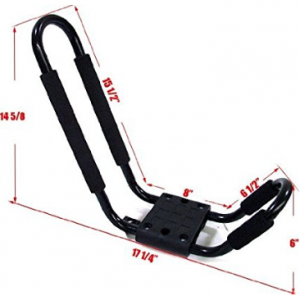
The roof rack styled kayak trailer is typically comprised of two, and sometimes three, holders, depending on the size of your vehicle. Once installed, simply slide your fishing kayak into the trailer, and secure with the included straps.
Traditional Kayak Trailer Overview
(Commissions Earned)
Malone Great for Fishing Kayaks!
The second type of kayak trailer is a “trailer” in the truest since of the word, insofar as it actually is “trailed” behind your vehicle of choice. In this instance, the distinction between towing your fishing kayak behind a truck, or behind your SUV, will matter, as two different styles of kayak trailers have evolved to perfectly suit each style of vehicle.
If towing from an SUV, you will simply insert the hitch to the receiver, secure the connection, insert your fishing kayak and be on your way. Importantly, the SUV style results in you actually towing your fishing kayak, which follows behind your SUV on the two wheeled kayak trailer system.
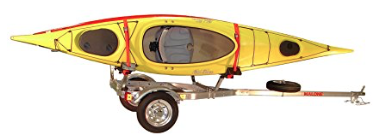
This kayak trailer, while certainly more difficult than a truck based system, as discussed below, is fairly compact and user friendly, even to those of us who are towing for our very first time. The trailer is built with a galvanized steel frame, heavy duty tires capable of supporting the weight of the fishing kayak, and often times comes with ropes and tie downs.
We do suggest purchasing a model that comes with precompiled electrical and brake lights, as many, if not all, states require that any fifth wheel contain these types of features.
Kayak Trailer – Kayak Trailer Hitch Overview
(Commissions Earned)
If towing your fishing kayak from a truck, you are fortunate to have a product that isn’t truly “towing”, but rather “carrying”. That’s right, the truck styled kayak trailer is actually a form of extension that is inserted into the hitch, and then extended out the back of the truck bed to act as an elongation of the truck bed.
This allows the fisherman to simply lay the majority of the fishing kayak in the truck bed, then lay the remainder out of the truck bed and safely into the catch created by the kayak trailer’s vertical posts.
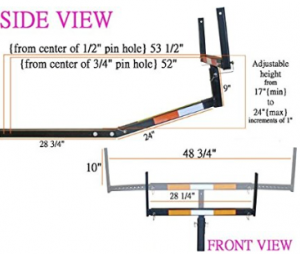
The support arm that connects the truck to the vertical posts is capable of adjustment in each height and width, allowing for the combination of fishing kayaks and trucks of nearly any shape and size.
Most truck style kayak trailers are built of heavy duty steel tubing, capable of supporting the weight of nearly any fishing kayak, and also feature glow in the dark or electronically wired safety beacons on the far end of the trailer, such that any vehicles that may approach from behind are on notice. Learn how to securely strap your fishing kayak to your kayak trailer here
Kayak Trailer – Kayak Cart Basics
(Commissions Earned)
A Great Mix of Balance and Control!
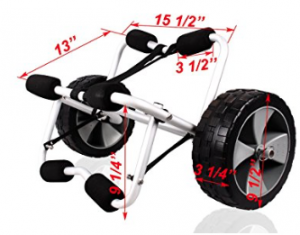
The third type of style is the land based trailer. This style is important once you have arrived at your water way with your fishing kayak, but still have a long walk to the launching point, perhaps over a parking lot or even down a steep embankment. While the vehicle based model or towable style will get your fishing kayak close to the water, it won’t be much help in those final few steps.
The land based style is typically designed with a central axel, and two concaved or V shaped supports that point upward from the trailer at approximately a 45 degree angle. The concaved nature of the supports create the perfect notch into which your fishing kayak can be inserted and safely held. The two supports on the product will act to balance the weight of your fishing kayak over the centralized axel, and the axel, in turn, balances the weight of the entire set up.
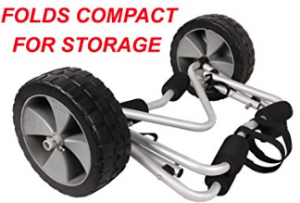
After you get the balance right, the fishing kayak’s weight is essentially eliminated by the kayak trailer design, and you are able to easily maneuver your fishing kayak across those final few steps and deploy it safely into the water. Typically these land based styles will feature foam bumpers on any contact point, and be crafted of high quality aluminum to provide adequate product strength, all while keeping the weight of the product down.
We suggest purchasing a land based mode that is foldable or collapsible such that it can be easily taken with you out onto the water, then simply redeployed when the time comes to bring your fishing kayak out of the water and back to your vehicle.
Buy the Best Kayak Trailer
(Commissions Earned)
Carry Multiple Kayaks at Once!
We decided to showcase what is bar none the best kayak trailer, in the traditional sense of the word, on the market today. We love the flexibility of this unit. Its user can easily remove and add back the kayak cradles shown above to meet the needs of the particular kayak fishing outing they will be embarking upon.
This trailer is our favorite because it is built with marine grade and pre-galvanized steel and measures an impressive 78 inches wide and 164 inches long. Its tires are of a quality that can support this wide frame. The spacious frame also affords the user with a versatile platform upon which to load a fishing kayak or any number of pieces of related gear.
What else did we love about this trailer? It supports loads of up to 350 pounds, which is more than enough capacity for a number of fishing kayaks. You can also haul fishing kayaks of up to 19 feet long, which of course easily accommodates the size of most fishing kayaks.
Finally, it also comes with a heavy duty fail safe chain to give even further assurance of the safety of your fishing kayak while it is under transport. Let’s face it, kayak fishing involves travel on some bumpy roads! Lastly, when we most recently checked, we saw the kayak trailer was listed for a pretty reasonable price, especially when you consider everything that comes with it! If you want to see a similar kayak trailer, check out the Malone model!
Want to make sure that you are properly towing your fishing kayak? Check out this handy guide!
My Experience
I knew it was time to purchase a fishing kayak trailer when I was embarking on more and more solo kayak fishing trips, and when these trips began taking me to different bodies of water. Kayak fishing already involves a number of kayak fishing accessories, and I was discovering that simply transporting my kayak fishing set up was becoming increasingly cumbersome.
I decided to purchase a vehicle based fishing trailer and a land based style, each of which you’ve learned about above, and found that my trips to and from my car quickly reduced to a more manageable number.
Not only that, by the land based kayak fishing trailer allowed me to navigate rocky shorelines and travels from distant parking lots with ease, not to mention keeping me from having the sore arms that often times followed instances where I had physically lifted and carried my fishing kayak great distances.
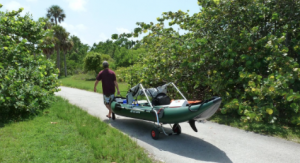
Overall, the fishing trailer is one of the products I recommend most strongly to kayak fishermen of all abilities, because it adds an immediate level of enjoyment in terms of the efficiency and flexibility it provides you. Plus, it allows you to experience kayak fishing on several different bodies of water, rather than being logistically constrained to nearby areas. Try it out!
CONCLUSION
I hope that this guide has helped you learn more about the different types of kayak trailer. We are truly fortunate to be living in a time where the popularity of kayak fishing is correlating with new products being introduced that make the kayak fishing experience more accessible and enjoyable.
Transportation of your fishing kayak can be a cumbersome ordeal, but it doesn’t have to be, thanks to the trailer! We highly recommend that the readers of kayakfishingcorner purchase some form of the above as one of the kayak fishing “must have” devices.
Each type of system has its redeeming qualities, and frankly there is very little drawback to any of them. Each is removable, navigable, sturdy, and features a remarkable ease of use, especially when compared to all the trouble you will save yourself (and your fishing kayak!) from trying to drag the fishing kayak along the ground, carry by yourself (or even with a friend), or stuff in the back of an undersized truck or SUV. Try it out, you’ll be glad you did!
Still not convinced? Check out the Top 5 Things People Love About Kayak Trailers to learn more! Want to learn more about kayak fishing before deciding on a trailer, this post will tell you everything you need to know about kayak fishing! If you have any questions about the kayak trailer in general, please post a comment at the bottom of this page or message me! Here are some additional tips for those of you who may be new to using a trailer!
Comments
Do you have any kayak trailer facts or questions about the kayak trailer? Please share with the rest of the KayakFishingCorner community by posting in the Comments section below.
Related Popular Posts


